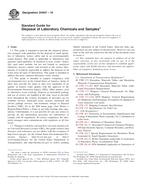Potřebujeme váš souhlas k využití jednotlivých dat, aby se vám mimo jiné mohly ukazovat informace týkající se vašich zájmů. Souhlas udělíte kliknutím na tlačítko „OK“.
ASTM C1207-10
Standard Test Method for Nondestructive Assay of Plutonium in Scrap and Waste by Passive Neutron Coincidence Counting
Automaticky přeložený název:
Standardní zkušební metoda pro nedestruktivní plutonia v šrotu a odpadu by Pasivní Neutron Koincidenční počítání
NORMA vydána dne 1.6.2010
Informace o normě:
Označení normy: ASTM C1207-10
Poznámka: NEPLATNÁ
Datum vydání normy: 1.6.2010
Kód zboží: NS-10037
Počet stran: 11
Přibližná hmotnost: 33 g (0.07 liber)
Země: Americká technická norma
Kategorie: Technické normy ASTM
Kategorie - podobné normy:
Anotace textu normy ASTM C1207-10 :
Keywords:
nondestructive assay, passive neutron coincidence counting, plutonium, scrap and waste, Coincidence counting, Electrical measurements, Neutron counting, Nondestructive evaluation (NDE)--nuclear applications, Nuclear scrap and waste materials, Plutonium--nuclear scrap and waste materials, Thermal-neutron coincidence counting, ICS Number Code 13.030.30 (Special wastes)
Doplňující informace
| Significance and Use | ||||||||||||||||||||||||||||||
|
This test method is useful for determining the plutonium content of scrap and waste in containers ranging from small cans with volumes of the order of a mL to crates and boxes of several thousand liters in volume. A common application would be to 208-L (55-gal) drums. Total Pu content ranges from 10 mg to 6 kg (1). The upper limit may be restricted depending on specific matrix, calibration material, criticality safety, or counting equipment considerations. This test method is applicable for U.S. Department of Energy shipper/receiver confirmatory measurements (9), nuclear material diversion detection, and International Atomic Energy Agency attributes measurements (10). This test method should be used in conjunction with a scrap and waste management plan that segregates scrap and waste assay items into material categories according to some or all of the following criteria: bulk density, the chemical forms of the plutonium and the matrix, americium to plutonium isotopic ratio, and hydrogen content. Packaging for each category should be uniform with respect to size, shape, and composition of the container. Each material category might require calibration standards and may have different Pu mass limits. Bias in passive neutron coincidence measurements is related to item size and density, the homogeneity and composition of the matrix, and the quantity and distribution of the nuclear material. The precision of the measurement results is related to the quantity of nuclear material, the (α,n) reaction rate, and the count time of the measurement. For both benign matrix and matrix specific measurements, the method assumes the calibration reference materials match the items to be measured with respect to the homogeneity and composition of the matrix, the neutron moderator and absorber content, and the quantity of nuclear material, to the extent they affect the measurement. Measurements of smaller containers containing scrap and waste are generally more accurate than measurements of larger items. It is recommended that where feasible measurements be made on items with homogeneous contents. Heterogeneity in the distribution of nuclear material, neutron moderators, and neutron absorbers have the potential to cause biased results. The coincident neutron production rates measured by this test method are related to the mass of the even number isotopes of plutonium. If the relative abundances of these isotopes are not accurately known, biases in the total Pu assay value will result. Typical count times are in the range of 300 to 3600 s. Reliable results from the application of this method require training of the personnel who package the scrap and waste prior to measurement and of personnel who perform the measurements. Training guidance is available from ANSI 15.20, Guides , C1009, C1068, and C1490. |
||||||||||||||||||||||||||||||
| 1. Scope | ||||||||||||||||||||||||||||||
|
1.1 This test method describes the nondestructive assay of scrap or waste for plutonium content using passive thermal-neutron coincidence counting. This test method provides rapid results and can be applied to a variety of carefully sorted materials in containers as large as several thousand liters in volume. The test method applies to measurements of 238Pu, 240Pu, and 242Pu and has been used to assay items whose total plutonium content ranges from 10 mg to 6 kg (1). 1.2 This test method requires knowledge of the relative abundances of the Pu isotopes to determine the total Pu mass (Test Method C1030). 1.3 This test method may not be applicable to the assay of scrap or waste containing other spontaneously fissioning nuclides. 1.3.1 This test method may give biased results for measurements of containers that include large amounts of hydrogenous materials. 1.3.2 The techniques described in this test method have been applied to materials other than scrap and waste (2, 3). 1.4 This test method assumes the use of shift-register-based coincidence technology (4). 1.5 Several other techniques that are often encountered in association with passive neutron coincidence counting exist These include neutron multiplicity counting (5, 6, Test Method C1500), add-a-source analysis for matrix correction (7), flux probes also for matrix compensation, cosmic-ray rejection (8) to improve precision close to the detection limit, and alternative data collection electronics such as list mode data acquisition. Passive neutron coincidence counting may also be combined with certain active interrogation schemes as in Test Methods C1316 and C1493. Discussions of these established techniques are not included in this method. 1.6 This standard does not purport to address all of the safety concerns, if any, associated with its use. It is the responsibility of the user of this standard to establish appropriate safety and health practices and determine the applicability of regulatory limitations prior to use. |
||||||||||||||||||||||||||||||
| 2. Referenced Documents | ||||||||||||||||||||||||||||||
|
Podobné normy:
Historická
1.6.2009
Historická
1.1.2010
Historická
1.6.2011
Historická
1.6.2011
Historická
15.11.2006
Historická
1.5.2010
Doporučujeme:
Aktualizace technických norem
Chcete mít jistotu, že používáte pouze platné technické normy?
Nabízíme Vám řešení, které Vám zajistí měsíční přehled o aktuálnosti norem, které používáte.
Chcete vědět více informací? Podívejte se na tuto stránku.



 ASTM C1682-09
ASTM C1682-09 ASTM C1718-10
ASTM C1718-10 ASTM C1750-11
ASTM C1750-11 ASTM C1751-11
ASTM C1751-11 ASTM D4447-10
ASTM D4447-10 ASTM D5608-10
ASTM D5608-10
 Cookies
Cookies
